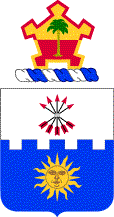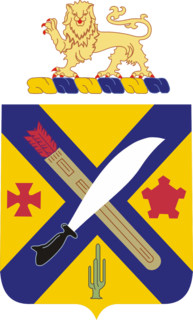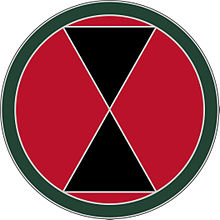
The 4th Infantry Division is a division of the United States Army based at Fort Carson, Colorado. It is composed of a division headquarters battalion, three brigade combat teams, a combat aviation brigade, a division sustainment brigade, and a division artillery.

The 7th Infantry Division is an active duty infantry division of the United States Army based at Joint Base Lewis-McChord charged with sustaining the combat readiness of two Stryker brigade combat teams, a combat aviation brigade, a division artillery headquarters, and a National Guard Stryker brigade combat team, as well as participating in several yearly partnered exercises and operations in support of U.S. Army Pacific and the Indo-Pacific region. The 7th Infantry Division is the only active-duty multi-component division headquarters in the Army. The 7th Infantry Division is also home to two of the Army's newest enabling battlefield capabilities, the Multi Domain Task Force and the Intelligence, Information, Cyber, Electronic Warfare and Space Capabilities, or I2CEWS battalion.

The 91st Infantry Division is an infantry division of the United States Army that fought in World War I and World War II. From 1946 until 2008, it was part of the United States Army Reserve. It was briefly inactivated from 2008 until 2010 when it was elevated back to a division size element as the 91st Training Division (Operations).

The 4th Battalion, 42nd Field Artillery Regiment nicknamed the Straight Arrows—was a field artillery battalion in the United States Army. The Regimental motto is Festina Lente.

The 22nd Infantry Regiment is a parent regiment of the United States Army. Currently the 2nd Battalion is active, with the regimental colors residing at Fort Drum, New York. The 1st, 3rd, and 4th Battalions have been inactivated.

The 12th Infantry Regiment is a unit of the United States Army. The 12th Infantry has fought in seven wars from the Civil War to the Global War on Terrorism and has been awarded 19 Presidential Unit Citations, five Valorous Unit Awards, a Joint Meritorious Unit Award, two citations in the Order of the Day of the Belgian Army, Nine Republic of Vietnam Crosses of Gallantry, the Republic of Vietnam Civil Action Honor Medal Third Class, a Meritorious Unit Commendation, and the Belgian Fourragere.

The 8th Infantry Regiment of the United States, also known as the "Fighting Eagles," is an infantry regiment in the United States Army. The 8th Infantry participated in the Mexican War, American Civil War, Philippine Insurrection, Moro Rebellion, World War I, World War II, Vietnam War, and Iraq Campaign.

The 1st Infantry Regiment is a regiment of the United States Army that draws its lineage from a line of post American Revolutionary War units and is credited with thirty-nine campaign streamers. The 1st Battalion, 1st Infantry is assigned as support to the United States Military Academy at West Point, New York and to furnish the enlisted garrison for the academy and the Stewart Army Subpost. 2nd Battalion, 1st Infantry Regiment is an infantry component serving with the 2nd Stryker Brigade, 2nd Infantry Division at Joint Base Lewis–McChord, Washington.

The 199th Infantry Brigade (Light) is a unit of the United States Army which served in the Army Reserve from 1921 to 1940, in the active army from 1966 to 1970, briefly in 1991–1992 at Fort Lewis, and from 2007 as an active army training formation at Fort Benning.

The 2nd Infantry Regiment is an infantry regiment in the United States Army that has served for more than two hundred years. It was constituted on 12 April 1808 as the 6th Infantry and consolidated with 4 other regiments in 1815 to form the present unit.

The 189th Infantry Brigade is an Infantry brigade of the United States Army based at Joint Base Lewis-McChord, Washington. It is a training brigade subordinate to First Army.

The 188th Infantry Brigade is an infantry training brigade of the United States Army based at Fort Stewart, Georgia. It is a subordinate unit of the First United States Army, Division East.

The 181st Infantry Brigade is an infantry brigade of the United States Army based at Fort McCoy, Wisconsin. As a First Army brigade, the unit serves primarily in a partnering and training role for Reserve Units. The brigade is subordinate to the First United States Army, headquartered at Rock Island Arsenal, Illinois. It has ten subordinate battalions.

The 174th Infantry Brigade is an infantry brigade of the United States Army based at the Fort Dix entity of Joint Base McGuire-Dix-Lakehurst, New Jersey. A multi-component training unit, the brigade provides operational training and increased readiness for units in the continental Northeast.
The 32nd Infantry Regiment is a battalion within the United States Army. Of the original regiment, only the 1st Battalion remains as an active duty unit. The 1st Battalion, 32nd Infantry Regiment is a light infantry battalion assigned to the 1st Brigade Combat Team, 10th Mountain Division, garrisoned at Fort Drum, New York. The battalion was previously assigned to the 3rd Brigade Combat Team at Fort Drum, before this unit was reflagged to Fort Polk, Louisiana.

The 1st Brigade, 7th Infantry Division was an infantry brigade of the United States Army, and a part of the 7th Infantry Division. The brigade was based at Fort Ord, California for most of its history. After the Korean War, it was activated as a brigade in 1963, and was returned to the United States where it saw action in Operation Just Cause and Operation Golden Pheasant before being finally deactivated in 1995.

The 3rd Brigade, 7th Infantry Division, originally known as the 14th Infantry Brigade was an infantry brigade of the United States Army, and a part of the 7th Infantry Division. The brigade was based at Fort Ord, California for most of its history.

The 12th Field Artillery Regiment is a unit of the United States Army.

The 14th Brigade Engineer Battalion is a Combat Engineer Battalion of the United States Army based at Joint Base Lewis-McChord, Washington. The battalion is a subordinate unit of the 2nd Stryker Brigade, 2nd Infantry Division, and I Corps. The battalion's official motto is "Gong Mu Ro" and battle cry "Rugged!".
The 2nd Battalion, 29th Field Artillery Regiment is a unit of the 4th Armor Brigade Combat Team of the 1st Armored Division, United States Army. The battalion is currently garrisoned at Fort Bliss, Texas.













